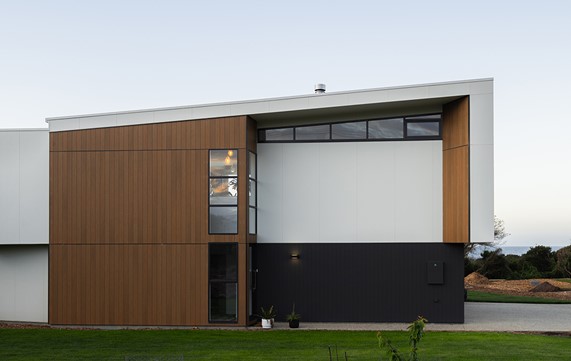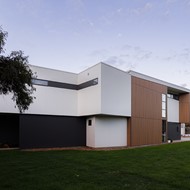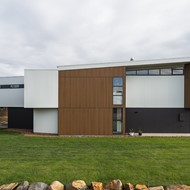The northern coast of Tasmania has a wild sort of beauty – making it both spectacular and challenging for homeowners. Bracing winds and salty air place a lot of demands on materials used for building.
However, this architect designed house overlooking the wide expanse of Bass Strait is the perfect solution for the site. With never-to-be-built-out views, open living spaces and a striking contemporary aesthetic, Aisling House certainly makes the most of its location.
S. Group worked with the owners of the property, both local doctors, to create a home that took advantage of the views while considering the exposed location. The house is located in Leith, a small little seaside community between Devonport and Ulverstone.
“It’s just off the highway, tucked away,” explains Damon Marshall, the lead designer on the project. “There’s actually quite a few houses in amongst the trees and along the little bit of coast there.”
The brief
Like many building projects, the scope of work for the house grew as the project progressed and the couple prepared their wishlist for their new home.
“The plan was always to downsize. But as we nutted things out and fleshed out the ideas, it did become a full size family home,” says Marshall. “They had a wishlist, so we made that work and integrated it with passive solar design and worked with the orientation. Aesthetically, it was driven primarily by us. If people don’t have a fully developed vision, then we’ll see what naturally happens during the design.”
Why Cemintel?
With all the environmental demands on the materials, Marshall says that Cemintel Territory was an obvious choice for the exterior cladding. He says it was important to specify something that was not only beautiful, but tough enough to cope with the location.
The house was built by Immersive Homes. Marshall chose Territory Woodlands, making it the hero of the exterior. The house is two storeys but designed in a way to make the top storey look like it’s floating over the landscape courtesy of a dark cladding on the ground floor.
Cemintel Territory is a favourite of S. Group, he says, because the panels are stain resistant and protect against UV damage and colour fade. The weather resistant joints are ideal for the conditions found in northern Tasmania, while the corrosive resistance framing system and concealed fixing systems help manage moisture through a ventilated cavity.
“As a palette across our company, we like to include cement sheets, but then specify something natural, such as timber, to help break it up, especially for residential projects. It’s nice to just have that timber in it, it adds warmth.” he explains.
“The flip side is that no one these days has time or wants to maintain timber. Cemintel Territory is a perfect product really – you don’t have to do anything to it. You just put it on, and it’s done. I love that about it.”
The Cemintel Territory Woodlands system is CodeMark Certified and achieves EW classification in accordance with AS5113:2016. Its aesthetics are complemented with its exceptional performance qualities as a non-combustible material with strong weather tightness attributes.
Mixed palette
In keeping with the modern aesthetic, the exterior has a mix of materials, but Territory Woodlands is the hero, framing key parts of the building. The timber look of Woodlands adds warmth to the exterior, creating a natural appearance that complements the home’s environment.
“The Cemintel is the highlight as far as materials go,” Marshall says. “We used dark cladding underneath to give the building a floating feel. It’s a two-storey home with all the living on the upper floor, so it rises above the coastal vegetation.”
“It’s all Crown Land in front that you can’t reduce or remove. So to get the proper ocean view everything is from that upper floor. You get snippets from ground level, but to really get the view you need to be higher. The vision was to create the impression of a single storey building that floated up off the ground.”
“We hope that it looks more like a single-storey building,” he says. “Obviously, it does look tall in certain angles and things, but we tried to break it into those two layers. We used the light colour upstairs and then we used the Cemintel to highlight certain areas.”
“We’ve got the Cemintel in three splashes, if you like,” he adds. “There’s one as you approach from the street side at the front door. There’s another section on the end, which is almost the money shot of the house, above the garage. So if you’re driving along the road that’s what you see first. And there it definitely looks like it’s floating, where the garage is recessed back, visually recessive.”
“So that end has a white shape around it and three-dimensional cantilevers in two directions on the corner. It’s a little bit of engineering magic there and we’ve used the Cemintel to really show that corner off, because that’s the side everyone sees.”
“And then around on the ocean side, there’s a little servery that pops out onto the deck, that’s also in the Cemintel. It’s all about highlighting those three zones.”
The solution for the trade shortage
With skilled trades in short supply across the country, including Tasmania, Cemintel is the ideal solution for a busy building site. Because it can be installed by the existing trades on site (usually carpenters), it reduces dependence on wet trades, such as bricklayers. It is non-combustible and also minimises waste onsite.
“In the current climate, another bonus to a material like Cemintel is just that one less trade is required,” says Marshall. “So that's a big tick. It's a real problem at the moment, the skill shortage, so any material that can be installed by the main trades people is great.”

















